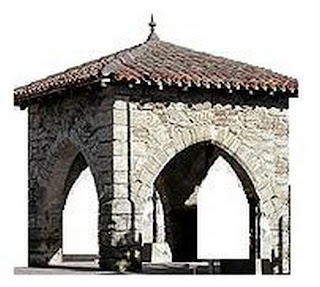. . .
M
OUSTEY AND ITS TWO CHURCHES
 Moustey The village has a special little town. Indeed, two churches are everywhere, a few meters from each other, one behind the other: the parish church of St. Martin, the largest, and Notre Dame. .... and therefore better than Colombey!
Moustey The village has a special little town. Indeed, two churches are everywhere, a few meters from each other, one behind the other: the parish church of St. Martin, the largest, and Notre Dame. .... and therefore better than Colombey! The origin of this strange rapprochement remains controversial and several hypotheses have been proposed to justify it by local incentives:
Local tradition sees the result of rivalry between two lords (Moustey being at the limit of two baronies) vying for supremacy to offices, or at least the consequences of popular hatred (the south wall of the church Notre Dame has a walled-up door pretending to access reserved for lepers called bigots)
More reasonably, one may think it is a parish church and chapel monastic Moustey front of his name the former French monastery
, from the popular Latin
monasterium
.

The parish church built in the XIII century stone and "garluche" (alias), has been enlarged by a low north side in the Gothic style in the late fifteenth century (the bottom side is north of the nineteenth).
The Notre Dame, called pilgrims, in Romanesque style but after the previous one, dated XV century, the chapel would be dependent on a hospital or hospice for pilgrims of Saint Jacques de Compostela . She was surrounded by civic buildings still visible on the Napoleonic cadastre could be the old priory. Besides, a house neighbor has disappeared had kept the name of the locality  Houspitaou
Houspitaou . This small hospital was demolished in 1872.
After the discovery of wall paintings in the plaster in 1985, the church was restored by the Regional Park of Landes de Gascogne, and hosted a time, a space devoted to religious heritage and popular beliefs Landes.
courrut EII tan, tan Birat
And n'ei treubat churches due to a Segrate
(J have both ran, turned and as ever I've found no two churches in a cemetery )
RION-DES-LANDES

the "crust Arramère"

 Normal 0
Normal 0 21
MicrosoftInternetExplorer4
/ * Style Definitions * / table.MsoNormalTable {mso-style-name: "Table Normal"; mso-tstyle-rowband-size 0; mso-tstyle-colband-size: 0; mso-style-noshow: yes; mso-style-parent: ""; mso-padding-alt: 0in 5.4pt 0in 5.4pt; mso-para-margin: 0in; mso- para-margin-bottom: .0001 pt; mso-pagination: widow-orphan; font-size: 10.0pt; font-family: "Times New Roman";}

This unique four-Gothic arcaded porch with no roof, and covered with a flattened roof, is located at the roadside, opposite the Post Office. It has a cross to which we once went in procession on Palm Sunday, hence its name
Palm Cross.

This portal is the only remnant of the Romanesque church of the twelfth century, rebuilt in the sixteenth, which was surrounded until 1834 a fortified belt enclosing the cemetery whose entrance was protected by a square tower.
The porch in front and the guard was added in the same style, during the restoration and expansion in 1868 .
Webs decorated with spirals, palmettos, twists, tympanum with Christ in glory ...
capitals
historiated

Daniel in the lions' den - the flight into Egypt. Presentation in the Temple - Lazarus and the rich man (?).
 var _gaq _gaq = == Document.location.protocol? 'Https: / / ssl': 'http://') + '.google-analytics.com/ga.js';
var _gaq _gaq = == Document.location.protocol? 'Https: / / ssl': 'http://') + '.google-analytics.com/ga.js'; var s = document.getElementsByTagName ('script') [0]; s.parentNode. insertBefore (ga, s);
})();
TRIBUTE TO THREE FORMER 
The Oak Quillacq

It was a long, long, one of the most remarkable giant trees and strange in the region, since he has been assigned to two millennia! Sheltering its fork into a source said to cure sore eyes, and was the object of veneration and pilgrimage Aboriginal People, especially the night of June 23 to 24, the feast of St. John the Baptist.
known until the 20th century as the tree of St John, the tree of pain, the tree fairies or witches.

Unfortunately, after the forest that surrounded it had been cut, it dwindled and eventually mourrr around 1930
Elm Biscarrosse
Oak Vincent de Paul


 official website developed by the city of Saint-Sever
official website developed by the city of Saint-Sever 

 remains a stone statue supposedly hidden on this occasion, and disappeared from the marshes, was rediscovered by chance in 1620, as so often in wonderful condition. It is thus that aired the tradition of the miracle of oxen stop, uncover and lick the statue of the Madonna and child in an isolated spot of the moor.
remains a stone statue supposedly hidden on this occasion, and disappeared from the marshes, was rediscovered by chance in 1620, as so often in wonderful condition. It is thus that aired the tradition of the miracle of oxen stop, uncover and lick the statue of the Madonna and child in an isolated spot of the moor. 

 ------------------------------------ -------------------------------------------------- ---------------------
------------------------------------ -------------------------------------------------- --------------------- 


 Houspitaou
Houspitaou 

 Normal 0
Normal 0 





